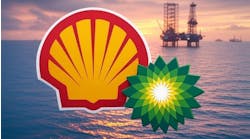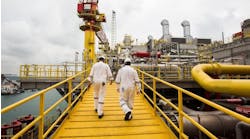Metal-to-metal expandable sealing device replaces elastomers
Baker Oil Tools recently added metal-to-metal, high-expansion Z-Seal technology to its product portfolio, increasing the capability of its downhole equipment to provide pressure integrity, particularly in hostile, high-pressure/high-temperature (HP/HT) environments.
According to Baker, this technology is a new, innovative, high-expansion sealing device that uses expanding metal in place of elastomers to form a high-integrity pressure seal on the tubular wall. The seal is made entirely of metal, making it highly insensitive to temperature failure and able to withstand high-pressure forces. Because it contains no elastomers, this seal dramatically improves downhole equipment performance in many well intervention applications and makes intervention possible in hostile well environments previously deemed inoperable. The metal seal expands up to 160% of its original size while maintaining true HP/HT performance. It also uses applied differential pressure to exert an additional self-energizing load to reinforce the seal.
The company explains that this seal system can be retracted fully in applications that require tool retrieval. Eliminating elastomers also dramatically improves downhole equipment performance by eliminating conventional failure modes such as temperature or chemical degradation, fatigue, and shearing.
The company says this seal technology offers many additional advantages, including a lower profile, a smaller OD for protection from mechanical damage, easier retrieval and less debris, chemical and gas resistance, and conformance to irregular bore shapes. Its operational advantages and engineering innovation have resulted in two major industry awards.
The company says the initial applications of this seal technology in bridge plugs and straddle assemblies have proven the technology and the potential of the products in the well-servicing market. Currently this technology is being used as a medium- to high-expansion solution for bridge plugs, straddle systems, and flow-control devices.
Sedco 702 will be equipped with Voraxial 2000 separator
Enviro Voraxial Technology Inc. will supply the Transocean semisubmersible rigSedco 702 with an offshore deck water drainage system that includes the EVTN’s proprietary Voraxial 2000 separator. The Sedco 702 will use this system to protect the environment by separating oil from drainage water prior to discharge.
The offshore deck water drainage system provides a discharge level of 15 ppm to meet local environmental requirements. The system will handle contaminated drill floor run-off water containing solids and drilling fluids. The Voraxial separator’s ability to conduct efficient separation without the need of a pressure drop allows for an easier installation and a cost reduction of cost. The system provides efficient separation with a small footprint, low energy requirement, and a no-pressure drop.
Contango drills exploration discovery at its Dutch prospect
Contango Oil & Gas Co.mpany drilled an exploration discovery well on its Dutch prospect (Eugene Island block 10), offshore Louisiana operated by Contango Operators Inc. (COI), a wholly-owned subsidiary of the company.
A production liner has been set, electric logs run, and the company continues to drill further. Contango’s independent third -party engineer estimates this well to have proved reserves net to Contango of 25 bcfe. Completion and testing operations have not begun, but first production is anticipated by year-end. Estimated costs net to Contango to bring this well to full production status are $2.7 million.
COI has an 18.3% working interest. Republic Exploration LLC (REX), a subsidiary in which the company owns a 43% interest, has a 65% working interest in Dutch. The net revenue interests to COI and REX are estimated to be approximatelyat 13% and 47%, respectively. The net revenue interest before payout to Contango, as a whole, is approximately 33%.
“This discovery is a superb complement to our LNG and Fayetteville Shale business,” says Kenneth R. Peak, Contango’s chairman and CEO.
BP and Shell to test riserless drilling in deepwater
The Ability Group initiated an NOK79 million ($12.25 million) joint- industry project with BP and Shell to test riserless drilling systems in deepwater. The company intends to perform a test on its latest riserless mud recovery system in water depths of 1,500 m (4,921 ft) on a BP or Shell well next year.
The technology, developed by subsidiary AGR Subsea, has been proven in other petroleum provinces including the North Sea, off Sakhalin Island, and in the Barents Sea. BP has been using it in the Caspian Sea to a point where the technology is becoming a commercial success. Now the Ability Group wants to extend its water depth range.
“Riserless mud recovery has been successfully used around the world in waters up to 400 m (1,312 ft) deep, said Roger Stave, president of AGR Subsea in Houston. “This project is pushing the boundaries once more.”
The technology provides a means of recirculating and re-using drilling fluids while drilling the top sections of a well. The benefits come from a reduction in the operating time of drilling rigs, which at day rates of more than $300,000 for most semisubmersibles, can be considerable. There also are benefits from reducing the environmental impact of drilling operations as it limits discharges to the sea.
According to BP, the system has been used on 25 wells so far, 20 of these in the Caspian. It has also been used with the Transocean semisubmersibleLegend on wildcat exploration wells off northern Sakhalin for a BP-Rosneft joint venture. Additionally, Statoil has used the system in the Barents Sea.
BJ will drive conductors for the Qatargas projects
BJ Tubular Services will drive conductors offshore Qatar for the Qatargas 3 and Qatargas 4 projects. The projects are being executed jointly by Qatar Liquefied Gas Co. Ltd., a joint venture between Qatar Petroleum and ConocoPhillips, Qatar Petroleum, and Shell, as sponsors of Qatar Liquefied Gas, prior to its incorporation as a joint venture.
Company personnel will use the S150 Hydrohammer to drive up to 31-in. x 26-in. (787-mm x 660-mm) conductors for QG3 and QG4. In addition to drive shoes and deviated drive shoes for these offshore drilling locations, the company will provide handling tools and cold cutting and pipe prepping services.
The gas field is 89 km (55 mi) from the northeastern coast of Qatar. Work on this two-year contract is scheduled to begin immediately, with the majority of services scheduled for completion by March 2007. All related services are being provided by the division’s base in Doha, Qatar.
Frank Hartley, Houston




